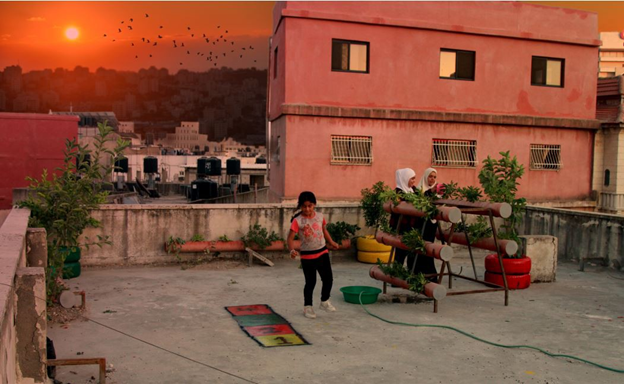
The Al-Am’ari refugee camp in Ramallah, Palestine, can be best described as a concrete jungle. Without any green spaces for planting kitchen gardens in the camp where nutritious food is hard to find, creative ideas are necessary.
Unpredictable climatic conditions and increasingly dense urbanization have brought food security into question for millions around the globe. In the face of these environmental and societal changes, it has become essential to implement adaptive solutions designed to address emerging and existent community needs. Atop teeming concrete surfaces can be found a green solution that offers to alleviate the urban heat island effect, improve air quality and supply local food to a city’s communities.
Rooftop gardens are a creative means to utilize the important fifth surface of any urban area. Though separated from the earth, flat rooftop surfaces can still act as a space where gardens can bloom by simply planting seeds in containers and ensuring sufficient watering. Unlike a traditional garden whose location requires open space with viable soil, rooftop gardens utilize materials that enable plant growth despite a lack of access to unused space. Rooftop gardens enhance the social, economic, and environmental sustainability of communities and cities. Further research also links the presence of urban green spaces to a reduction in anxiety and depression, thus contributing to residents’ mental health over and above the tangible benefits (Nutsford & Kingham, 2013).

This process of transforming a previously unutilized space into a productive ecosystem serves to develop a community’s ability to produce its own food, manage community-scale operations and increase biodiversity, and initiatives of this nature are consistent with several of the United Nations Sustainable Development Goals that serve as a shared blueprint for peace and prosperity for people and the planet (United Nations, SDGs). Accordingly, urban gardens can be implemented in a variety of settings to achieve several social development goals such as economic empowerment.
One such case of a rooftop gardening initiative can be found on the rooftops of al-Am’ari Refugee Camp in Ramallah, Palestine. Al-Am’ari camp was established in 1949 and today has an urban density of 73,000 people per square km, greater than that of Mumbai. From the sky, the camp appears to be one large concrete surface meaning there is no rainwater recharge and green spaces are not available for public enjoyment. In addition to these environmental challenges, unemployment rates are high among the camp’s residents, especially among women and 75% of women aged 20-24 are unemployed nor enrolled in educational programs.
The objectives of Planting Hope were simple: turn concrete surfaces into productive green space and foster independence from food markets to promote nutrition security.
Adopted in 2017 by the al-Am’ari Women’s Center, the Planting Hope rooftop gardening initiative was first proposed by a local civil and environmental engineer and social entrepreneur from al-Am’ari. The objectives of Planting Hope were simple: turn concrete surfaces into productive green space and foster independence from food markets to promote nutrition security. Beginning with a small group undertaking a pilot garden, the project then quickly moved to the capacity-building phase with over 50 households in the camp now currently involved.
Despite low initial interest, the women of al-Am’ari eventually dared to challenge the conditions of the camp and adopted the Planting Hope rooftop gardening initiative with enthusiasm and pride. This has resulted in women being trained in small-scale gardening techniques and business management skills, giving them the knowledge and the means to produce food or aromatic plants in a space previously unused.

Once solely consumers, these women are now successful gardeners with popular crops turning out to be cucumber, spinach, lavender, and rosemary. The product can be either consumed directly or sold as a source of income, enabling women to be active participants in the local economy. One gardener, Sara, a 35-year-old pregnant mother, shared that the spinach she grew improved the health of herself and her baby by providing the vitamins and iron that she otherwise would not have received as buying at the market would have been too expensive. This is one example of how the Planting Hope initiative has been successful in reducing market dependence and increasing food and nutrition security by introducing communal green spaces in the urban environment.
However, there are several challenges to be expected while establishing and operating community rooftop gardens such as in al-Am'ari. Firstly, adaptability during the capacity-building stage was crucial in order to ensure a substantial transfer of the necessary skills and knowledge. Illiteracy was common among the women; thus, all technical information was explained using visual aids and communication forums were carried out with voice messages. These adjustments effectively showed how illiteracy can be removed as a barrier to meaningful involvement in this community endeavor. Secondly, in the early stages, outside funding may be necessary as well as consultations with individuals that can provide technical guidance. Thirdly, finding an available rooftop and turning it into an attractive area for community members also takes an investment of time and resources.
Partnerships based on communication, patience, and unity will be able to address these challenges in order to fulfill the rooftop project’s objectives. Just as the rooftops can transform from concrete to colorful community oases, so too can community members develop their skills and capabilities through the process of creating solutions to the challenges they confront.
However, partnerships based on communication, patience, and unity will be able to address these challenges in order to fulfill the rooftop project’s objectives. Just as the rooftops can transform from concrete to colorful community oases, so too can community members develop their skills and capabilities through the process of creating solutions to the challenges they confront.
As cities grow larger and more densely populated around the world, there is still the possibility for the bird’s eye view to contain abundant green spaces. This case study of the al-Am’ari women is one example of rooftop gardening, a practice that has demonstrated potential as a method of community-based empowerment whether concerning food security, economic opportunity, or marketable skills.
References:
Nutsford, D., Pearson, A. L., & Kingham, S. (2013). An ecological study investigating the association between access to urban green space and mental health. Public health, 127(11), 1005-1011.
United Nations. (n.d.). The 17 goals | sustainable development. United Nations. https://sdgs.un.org/goals
Brian Crann


